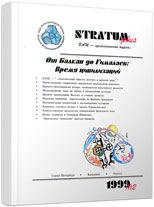О контактах культур степной бронзы с земледельцами Южного Туркменистана в эпоху поздней бронзы (по материалам поселений Теккем-депе и Намазга-депе)
On the contacts of steep bronze cultures with farmers of Southern Turkmenistan (according to materials of Tekkem-depe and Namazga-depe)
Author(s): Anatolii Ya. ShchetenkoSubject(s): History, Archaeology, Cultural history, Economic history, Ancient World
Published by: Издательский дом Stratum, Университет «Высшая антропологическая школа»
Summary/Abstract: The settlement of «Vyshka» («Watch-Tower») Namazga-depe and settlement of Tekkem-depe are situated in southern Turkmenistan, 117 and 119 km southeast of Ashgabat (Fig. 1.1). Materials of the upper levels (5.5-6 m) of «Vyshka» Namazga-depe (fig. 1. 2,3) and the same levels Tekkem-depe (fig. 1. 4,5) are attributed to the Late Bronze Age and the Early Iron Age. Here there are the convincing proofs (pottery, metal and stone implements) of the contacts of farmers of Southern Turkmenistan with steep culture tribes of Eurasia. Pottery comprise several types of pots having flat bottom and various dimensions (fig. 2. 1,2; fig. 3. 5,6). Ornamentation is limited with the six simplest elements (incisions, herring-bone pattern, zigzags, crosses, relief ledges, zigzags, triangles) which are by zones in the upper part of vessels: on the rims, on the shoulders sometimes on the necks (fig. 2. 3,3; fig. 3. 1-4, 7-10). Metal implements known on stone casting forms (fig. 5. 1,3,5-8) comprise double-edged knifes with ring stop on the handle, pins with cross-like pommel, round buttons with buttonhole. Stone objects: anvils, mortars, mullers, grinders, pestles, hammers (fig. 5) together with the copper slag and four furnaces testify to the local metal treatment on both the settlements. A set of these objects together with pottery have analogies in materials of the cultures of Andronovo archaeological unity as well as in monuments of the final stage of the Late Bronze Age of Southern Urals, Northern and Eastern Kazakhstan. One may suppose the presence of several stage of cultural interactions of the farmers of Southern Turkmenistan with cattle-breading tribes: the early stage - epoch of the Late Namazga VI (the Alackul- Fjedorovo complexes) and the late stage - period of Anau IV/Yaz I (Sargary- Aleckseevo pottery).
Journal: Stratum plus. Археология и культурная антропология
- Issue Year: 1999
- Issue No: 2
- Page Range: 323-335
- Page Count: 13
- Language: Russian

